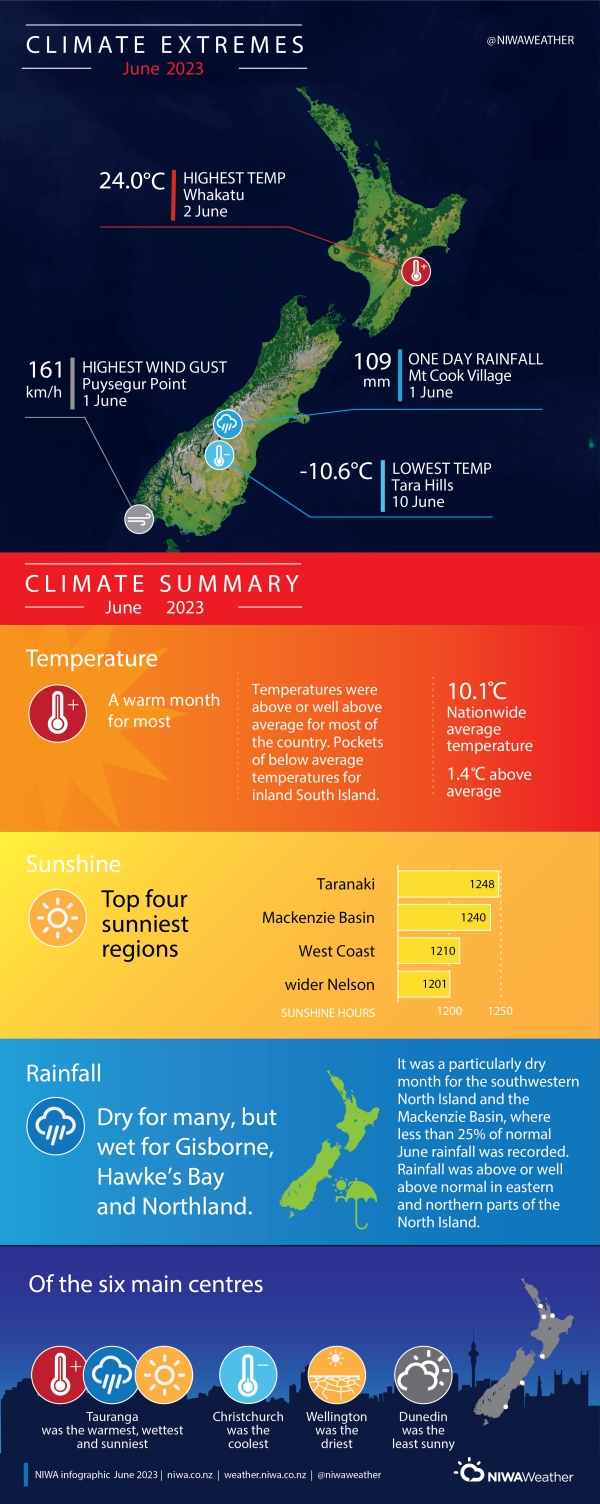Warm and dry for many, but wet in the east and north of North Island
|
Temperature |
Temperatures were above average (0.51-1.20°C above average) or well above average (>1.20°C above average) for many parts of the country. Near average temperatures (±0.50°C of average) were observed in parts of Northland, Auckland, and inland parts of Canterbury, Otago, and Southland. Temperatures were below average (0.51-1.20°C below average) in parts of the southern Mackenzie Basin and Central Otago. |
|
Rainfall |
Rainfall was below normal (50-79% of normal) or well below normal (<50% of normal) for inland, western, and southern parts of the North Island, and the majority of the South Island. Rainfall was above normal (120-149% of normal) or well above normal (>149% of normal) for eastern and northern parts of the North Island. |
|
Soil Moisture |
At the end of the month, soil moisture levels were higher than normal for Gisborne, parts of Hawke’s Bay, coastal North Canterbury, Central Otago, and Dunedin. Soil moisture levels were lower than normal for parts of South Canterbury. Near normal soil moisture levels were typical for the remainder of the country. |
Overview
June 2023 mean sea level air pressure was higher than normal over and to the south-east of the South Island, and lower than normal to the north of Aotearoa New Zealand. This was associated with more easterly winds than normal for the month overall, especially over the North Island – a lag effect of the La Niña event that ended earlier in the year. The lack of cold southerly air flows and ongoing warmer than average sea surface temperatures meant it was a warm start to winter for most of the country. The exception was parts of the inland South Island which were trapped under a prolonged inversion, due to the persistence of high pressure. This resulted in areas of persistent low cloud and fog, frequent frosts, and a challenging start to the ski season due to a lack of natural and artificial snow (see Highlights and extreme events section for more details).
Temperatures were above average (0.51-1.20°C above average) or well above average (>1.20°C above average) for many parts of New Zealand, but especially for coastal parts of the South Island, and throughout the North Island south of Auckland. In contrast, temperatures were below average (0.51-1.20°C below average) about the southern Mackenzie Basin and parts of Central Otago. Here, regular frosts and low daily maximum temperatures prevailed under high atmospheric pressure, which trapped cold air at low elevations in inland valleys and basins. Temperatures were near normal (±0.50°C of average) for inland parts of Southland, Otago, and Canterbury, as well as in Northland. Overall, the nationwide average temperature in June 2023 was 10.1°C. This was 1.4°C above the 1991-2020 June average, making it New Zealand’s 5th-warmest June since NIWA’s seven station temperature series began in 1909.
Rainfall was below normal (50-79% of normal) or well below normal (<50% of normal) for western and southern parts of Waikato, the Central Plateau, Taranaki, Manawatū-Whanganui, Kāpiti Coast, southern Wairarapa, Wellington, Tasman, Marlborough, West Coast, most of Canterbury, western Otago, and Southland. Rainfall was above normal (120-149% of normal) or well above normal (>149% of normal) for eastern and northern parts of the North Island including Hawke’s Bay, Gisborne, western Bay of Plenty, Hamilton, Coromandel, northern Auckland, and Northland. Rainfall was near normal for central and southern parts of Auckland, Nelson, Central Otago and Dunedin.
Further Highlights:
- The highest temperature was 24.0°C, observed at Whakatu on 2 June.
- The lowest temperature was -10.6°C, observed at Tara Hills on 10 June.
- The highest 1-day rainfall was 109 mm, recorded at Mt Cook Village on 1 June.
- The highest wind gust was 161 km/h, observed at Puysegur Point on 1 June.
- Of the six main centres in June 2023, Tauranga was the warmest, wettest, and sunniest, Christchurch was the coolest, Wellington was the driest, and Dunedin was the least sunny.
- Of the available, regularly reporting sunshine observation sites, the sunniest four locations in 2023 so far are Taranaki (1248 hours), Mackenzie Basin (1240 hours), West Coast (1210 hours) and wider Nelson (1201 hours).
Download:
- Climate Summary June 2023 [PDF 461 KB]
- Climate Statistics June 2023 [PDF 220KB]


